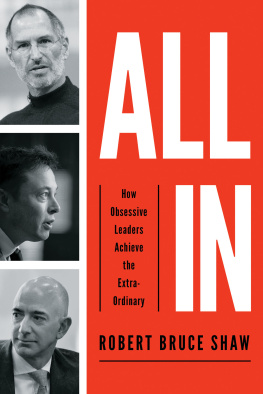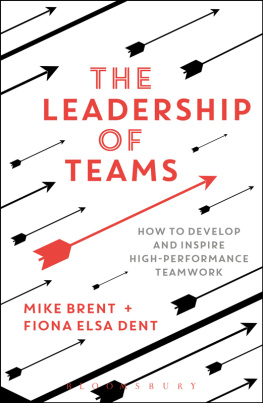Thank you for downloading this AMACOM eBook.
Sign up for our newsletter, AMACOM BookAlert, and receive special offers, access to free samples, and info on the latest new releases from AMACOM, the book publishing division of American Management Association.
To sign up, visit our website: www.amacombooks.org

EXTREME TEAMS
EXTREME TEAMS
WHY PIXAR, NETFLIX, AIRBNB, AND OTHER CUTTING-EDGE COMPANIES SUCCEED WHERE MOST FAIL
ROBERT BRUCE SHAW

To J. Richard Hackman
and his passionate quest to build better teams
CONTENTS
INTRODUCTION
REVOLUTIONIZING THE
WAY WE WORK

The company offers a broad range of worker-friendly programs, such as profit sharing, team performance bonuses, employee health and well-being incentives, and time-off sabbaticals. One program, for example, enrolls team members in a weeklong clinic that includes health seminars, medically supervised health testing, discussions with nutritionists, and cooking classes. Whole Foods, in short, is a purpose-driven company that takes very good care of its people.
The company, now with 450 stores and 86,000 employees, is built around small, highly focused, and cohesive teams. Each new hire becomes a member of a team within a storesuch as produce, meat, seafood, bakery, or prepared foods. These teams range in size The degree of autonomy that these teams have in Whole Foods is exceptional in an industry where almost everything sold in a neighborhood grocery store is dictated by a few people sitting in a stores central headquarters office.
The teams at Whole Foods also have a great deal of power in the management of people. Consider that store employees are largely responsible for hiring new people. Job candidates are interviewed by a small group of team members. The interviewers ask focused questions regarding the job candidates knowledge (What are the advantages of locally grown produce?), love of food (Describe a meal you recently ate in as much detail as possible.), customer orientation (Describe a time when you disappointed a customer. How did you fix it?), and level of personal awareness (If you dont get this job, why would that be the case?). Gaining the approval of those on the interview panel is only the first hurdle that a job candidate must overcome. Each team, after working with a new hire for several months, votes as a group on who stays and who goes. In other words, the members of a produce team, not the teams leader or the store manager, will decide if a new member remains on that team. A new hire is voted out if team members conclude that he or she lacks what is needed to contribute to the teams success. The vetting of new members is treated seriously because teams are rewarded in Whole Foods based on team performance in areas such as overall sales and profit per labor hour. A team bonus is paid monthly, which can result in thousands of extra dollars each year for the members of a successful group.performance metrics compared to the meat or seafood teams within its own store. Team leaders can also compare their teams performance against other teams across a region. New team members who do not pull their weight pose two risks. First, poor performers can reduce the bonus pay of all team members if the teams results suffer. That gets everyones attention. Second, weak members can damage a teams reputation, as each teams results are posted within each store. Reputation is no small matter in a company where ownership of results resides with each team.
New hires at Whole Foods need two-thirds of their team members to vote yes if they are to remain with the company. In the vast majority of cases, new hires are accepted by their team. But there are cases where individuals fail to gain the necessary team support. For instance, one team member was rejected after he repeatedly took an overly casual approach to working with customers (such as putting his hands in his pockets and sitting on counters). He was warned by his colleagues to change his demeanor, but he failed to realize that this feedback from his peers was important. A Whole Foods manager described the dynamic within the companys teams: There are people who are really good about working when the manager is on the floor... but as soon as the manager disappears, they lose control.... Im not the one you need to impress. Its your fellow team members. And they will be as tough as they can be, because ultimately [the hiring decision] will be a reflection on them.
Being voted in by ones new team fosters an emotional investment in the teams success and the overall success of Whole Foods. More generally, the company emphasizes the importance of team member happiness and a friendly work setting. Team meetings both in the stores and headquarters often end with what the company calls appreciations. Team members, each in turn, express thanks for the support that another team member provided as they worked together or, more generally, his or her contribution to the company. While this can seem somewhat new age to those joining the company or to outsiders, the practice

Three guiding principles underlie the team environment at Whole Foods. First, the company believes that people are by nature social beings who feel most comfortable when part of a small group. From this perspective, building a company around teams is building a company based on human nature. Everyone in the company belongs to at least one team. The most basic are those working within each store. The leaders of these teams are members of the leadership group running a store. The leader of each store is also a member of a regional leadership teamand so it goes to the top of the company. But Whole Foods doesnt use teams simply to provide its employees with a sense of community. The firm believes that teams, when designed and staffed properly, also maximize what people can contribute to the success of a business. John Mackey, one of the firms founders, set out to build a company that taps into each individuals creativity and potential:
Working in teams creates familiarity and trust and comes naturally to people. Humans evolved over hundreds of thousands of years in small bands and tribes. Its deeply fulfilling for people to be part of a team, where their contributions are valued and the team encourages them to be creative and make contributions. A well-designed team structure taps into otherwise dormant sources of synergy, so that the whole becomes greater than the sum of the parts. The team culture of sharing and collaboration is not only fundamentally fulfilling to basic human nature, it is also critical for creating excellence within the workplace.
A second management principle shapes how teams operate at Whole Foods. The company believes teams function best when they embrace a set of company-wide practices. Teams at Whole Foods have a great deal of autonomy to make decisions that benefit customers, team members, and the company. But they must follow a few standard proceduresfor example, voting on retaining new hires or awarding bonuses based on company measures, such as team profit per labor hour. Whole Foods strives to keep its required practices to a minimum, believing that less is more when it comes to limiting what its teams can do at a store level. Whole Foods does, however, follow through on the practices it believes are essentialincluding a relentless focus on tracking and rewarding team performance. The company tracks a range of quality and service metrics.freedom to operate within a set of shared company practices and metrics, its democratic discipline.
Next page











